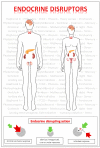Impact of Chemical Endocrine Disruptors and Hormone Modulators on the Endocrine System
- PMID: 35628520
- PMCID: PMC9145289
- DOI: 10.3390/ijms23105710
Impact of Chemical Endocrine Disruptors and Hormone Modulators on the Endocrine System
Abstract
There is growing concern regarding the health and safety issues of endocrine-disrupting chemicals (EDCs). Long-term exposure to EDCs has alarming adverse health effects through both hormone-direct and hormone-indirect pathways. Non-chemical agents, including physical agents such as artificial light, radiation, temperature, and stress exposure, are currently poorly investigated, even though they can seriously affect the endocrine system, by modulation of hormonal action. Several mechanisms have been suggested to explain the interference of EDCs with hormonal activity. However, difficulty in quantifying the exposure, low standardization of studies, and the presence of confounding factors do not allow the establishment of a causal relationship between endocrine disorders and exposure to specific toxic agents. In this review, we focus on recent findings on the effects of EDCs and hormone system modulators on the endocrine system, including the thyroid, parathyroid glands, adrenal steroidogenesis, beta-cell function, and male and female reproductive function.
Keywords: adrenal; beta-cell; bisphenol; ovary; parathyroid; phthalates; physical agents; testis; thyroid.
Conflict of interest statement
The authors declare no conflict of interest.
Figures
References
-
- Committee ES Scientific Opinion on the hazard assessment of endocrine disruptors: Scientific criteria for identification of endocrine disruptors and appropriateness of existing test methods for assessing effects mediated by these substances on human health and the environment. EFSA J. 2013;11:3132.
-
- Slama R., Bourguignon J.P., Demeneix B., Ivell R., Panzica G., Kortenkamp A., Zoeller R.T. Scientific issues relevant to setting regulatory criteria to identify endocrine-disrupting substances in the European Union. Environ. Health Perspect. 2016;124:1497–1503. doi: 10.1289/EHP217. - DOI - PMC - PubMed
-
- Kim S., Lee J., Park J., Kim H.J., Cho G., Kim G.H., Eun S.H., Lee J.J., Choi G., Suh E., et al. Concentrations of phthalate metabolites in breast milk in Korea: Estimating exposure to phthalates and potential risks among breast-fed infants. Sci. Total Environ. 2015;508:13–19. doi: 10.1016/j.scitotenv.2014.11.019. - DOI - PubMed
Publication types
MeSH terms
Substances
LinkOut - more resources
Full Text Sources


